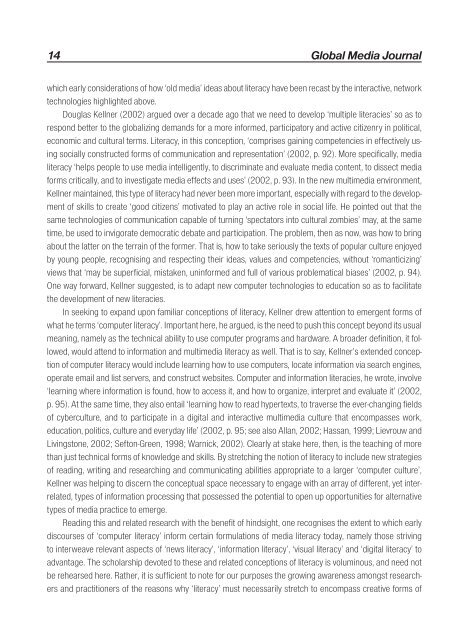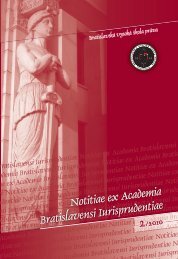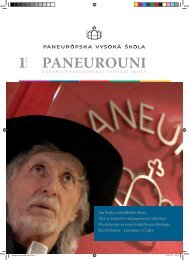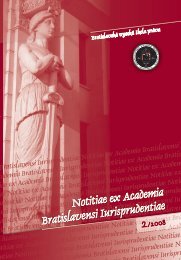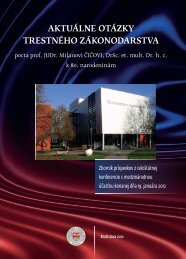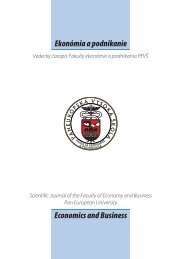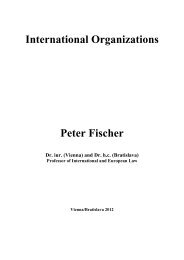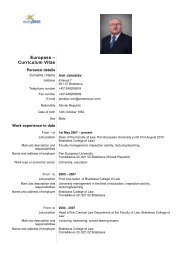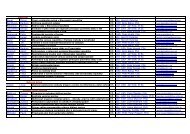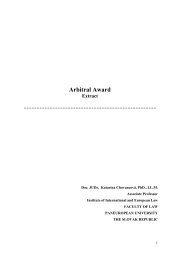ÄÃslo 1/2013 - Paneurópska vysoká Å¡kola
ÄÃslo 1/2013 - Paneurópska vysoká Å¡kola
ÄÃslo 1/2013 - Paneurópska vysoká Å¡kola
You also want an ePaper? Increase the reach of your titles
YUMPU automatically turns print PDFs into web optimized ePapers that Google loves.
14<br />
Global Media Journal<br />
which early considerations of how ‘old media’ ideas about literacy have been recast by the interactive, network<br />
technologies highlighted above.<br />
Douglas Kellner (2002) argued over a decade ago that we need to develop ‘multiple literacies’ so as to<br />
respond better to the globalizing demands for a more informed, participatory and active citizenry in political,<br />
economic and cultural terms. Literacy, in this conception, ‘comprises gaining competencies in effectively using<br />
socially constructed forms of communication and representation’ (2002, p. 92). More specifically, media<br />
literacy ‘helps people to use media intelligently, to discriminate and evaluate media content, to dissect media<br />
forms critically, and to investigate media effects and uses’ (2002, p. 93). In the new multimedia environment,<br />
Kellner maintained, this type of literacy had never been more important, especially with regard to the development<br />
of skills to create ‘good citizens’ motivated to play an active role in social life. He pointed out that the<br />
same technologies of communication capable of turning ‘spectators into cultural zombies’ may, at the same<br />
time, be used to invigorate democratic debate and participation. The problem, then as now, was how to bring<br />
about the latter on the terrain of the former. That is, how to take seriously the texts of popular culture enjoyed<br />
by young people, recognising and respecting their ideas, values and competencies, without ‘romanticizing’<br />
views that ‘may be superficial, mistaken, uninformed and full of various problematical biases’ (2002, p. 94).<br />
One way forward, Kellner suggested, is to adapt new computer technologies to education so as to facilitate<br />
the development of new literacies.<br />
In seeking to expand upon familiar conceptions of literacy, Kellner drew attention to emergent forms of<br />
what he terms ‘computer literacy’. Important here, he argued, is the need to push this concept beyond its usual<br />
meaning, namely as the technical ability to use computer programs and hardware. A broader definition, it followed,<br />
would attend to information and multimedia literacy as well. That is to say, Kellner’s extended conception<br />
of computer literacy would include learning how to use computers, locate information via search engines,<br />
operate email and list servers, and construct websites. Computer and information literacies, he wrote, involve<br />
‘learning where information is found, how to access it, and how to organize, interpret and evaluate it’ (2002,<br />
p. 95). At the same time, they also entail ‘learning how to read hypertexts, to traverse the ever-changing fields<br />
of cyberculture, and to participate in a digital and interactive multimedia culture that encompasses work,<br />
education, politics, culture and everyday life’ (2002, p. 95; see also Allan, 2002; Hassan, 1999; Lievrouw and<br />
Livingstone, 2002; Sefton-Green, 1998; Warnick, 2002). Clearly at stake here, then, is the teaching of more<br />
than just technical forms of knowledge and skills. By stretching the notion of literacy to include new strategies<br />
of reading, writing and researching and communicating abilities appropriate to a larger ‘computer culture’,<br />
Kellner was helping to discern the conceptual space necessary to engage with an array of different, yet interrelated,<br />
types of information processing that possessed the potential to open up opportunities for alternative<br />
types of media practice to emerge.<br />
Reading this and related research with the benefit of hindsight, one recognises the extent to which early<br />
discourses of ‘computer literacy’ inform certain formulations of media literacy today, namely those striving<br />
to interweave relevant aspects of ‘news literacy’, ‘information literacy’, ‘visual literacy’ and ‘digital literacy’ to<br />
advantage. The scholarship devoted to these and related conceptions of literacy is voluminous, and need not<br />
be rehearsed here. Rather, it is sufficient to note for our purposes the growing awareness amongst researchers<br />
and practitioners of the reasons why ‘literacy’ must necessarily stretch to encompass creative forms of<br />
GMJ Book.indb 14 21.1.<strong>2013</strong> 9:44


